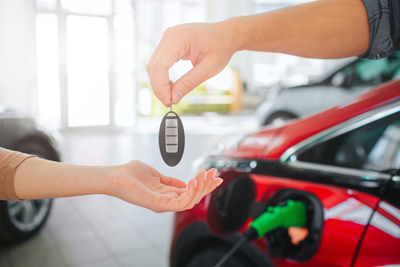The largest climate investment in U.S. history has dramatically reshaped the EV landscape.
One year ago, President Joe Biden signed the Inflation Reduction Act (IRA) into law, which set aside roughly $400 billion in federal funding for clean energy. Since then, carmakers and suppliers have announced more than $62 billion in investments in EVs, according to Bank of America research.
New clean energy projects announced have resulted in more than 86,000 reshoring and foreign direct investment manufacturing jobs while jobs related to EVs grew by 27%, more than 17 times that of gasoline and diesel vehicle jobs, according to data compiled by Bank of America.
"[There’s] something like a trillion-dollar shift from the federal government to the auto industry and the consumer," Tom Narayan, RBC Capital Markets lead global autos analyst, told Yahoo Finance. "All of these OEMs are trying to jump on this and capture and we're seeing that momentum already take place."
Since the law’s passage, Hyundai has poured billions of dollars into two new gigafactories in Georgia to build electric vehicles. BMW has announced a $1 billion investment to retool its South Carolina facility for EV production, along with a $700 million investment to build an electric battery plant nearby. And earlier this year, Toyota upped its investment in its North Carolina battery plant to nearly $6 billion, making the Liberty facility the largest single economic development project commitment in the state’s history.
"There’s a 10-year runway and frankly a lot of the hope is that we are subsidizing the learning by doing [it] early on, climbing the learning curve and sliding down the cost curve," Gernot Wagner, a climate economist at Columbia Business School, told Yahoo Finance. "Then it’s a runaway train that, yes, runs on clean electricity."
EV Tax Credits
The electric vehicle tax credit, which is aimed in large part at weaning U.S. reliance on China, has been the primary driver supercharging these investments.
The IRA requires half of the value of battery components be produced or assembled in North America to be eligible for a $3,750 credit. For an additional $3,750 credit, 40% of the value of critical minerals must also be sourced from the U.S. or a free trade partner.
It explicitly bans carmakers from using battery components "manufactured or assembled by a foreign entity of concern," referring to non-allied countries including China, starting in 2024.
The strict requirements and existing dependence on sourcing critical components from China have limited qualification to roughly a dozen EV models so far, including the Tesla Model 3 and Model Y. But the potential for a credit of up to $7,500 per new vehicle has spurred carmakers to realign their supply chains for the long term.
When the law was first signed, some electric vehicle makers, including startup Fisker, criticized the threshold to qualify for federal tax credits.
Fisker CEO Henrik Fisker questioned the effectiveness of strict sourcing and manufacturing guidelines that explicitly favored North America, saying they would "slow down the adoption of EVs" by limiting options for consumers.
Yet, in his company’s first Product Vision Day earlier in August, Fisker went onstage, touting U.S. manufacturing of his upcoming vehicles and the price reductions they would enjoy under IRA incentives.
"They have to be built here in the U.S. because we want to take advantage of the incentives," Fisker told Yahoo Finance, referring to the company’s electric pickup truck and SUVs. "We are looking at a couple of options."
Additional production credits in the IRA for battery cells and battery modules produced in the U.S. have only sweetened the deal for producers, Narayan said.
"A Chevy Equinox could be sold retail pre-credit for $30,000. You and I could get it for $20,000 at the same profitability," said Narayan, adding that American firms like General Motors, which recently opened its Ultium battery factory in Ohio, have been the biggest beneficiaries. "Everybody needs to build the cells locally in North America to qualify to get the $7,500 [EV credit] and the $35 [per kilowatt-hour battery] credit which completely more than offsets that capital expense of $2.6 billion per plant [for] GM."
Roughly half of all investment dollars stemming from the IRA have gone to EVs and batteries, resulting in an expanded annual battery production capacity of more than a million batteries, according to research from Bank of America.
While analysts say the direct impact of tax credits on EV adoption is too early to measure, sales of zero-emission vehicles have continued to see an uptick. Nearly 300,000 new EVs were sold in the second quarter, setting a new record in the U.S., according to a report by Cox Automotive. That marked a 48.4% increase from the same period last year.
"There's a lot of taxpayer money to help out with this," Morningstar U.S. autos equity analyst David Whiston said. "You're already seeing that when Tesla started with the initial 20% price cut on Model Y and then they've kept going with that with further cuts."
"There are people that probably would have normally bought a combustion model this year [saying], 'You know what? I'm gonna go electric and get that Model Y,'" Whiston added. "And the Model Y is driving a huge chunk of the EV market gains in the U.S."











